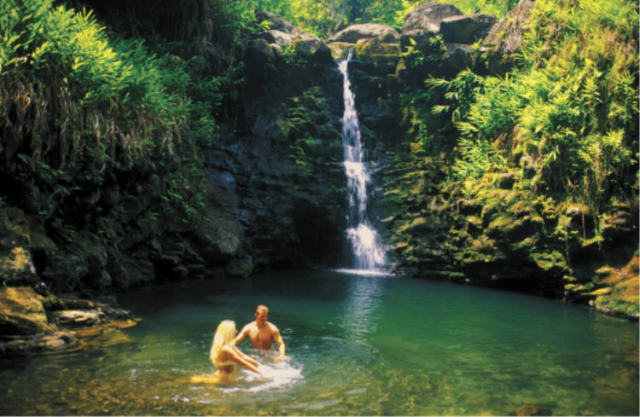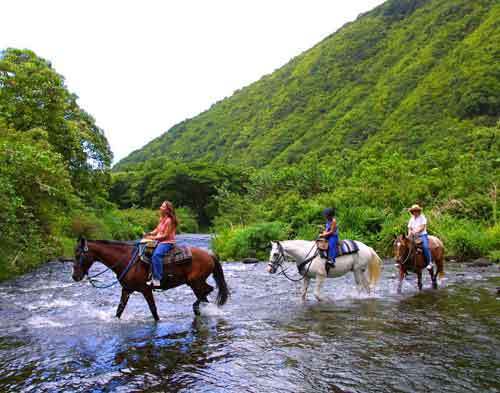In 2008, the Halemaumau Crater at the Volcanoes National Park on the Big Island of Hawaii began erupting in spectacular form. Unfortunately a by-product of this natural phenomenon is the release of high quantities of Volcanic Fog (also known as Vog) into the air. Vog is a hazardous mix containing sulfur dioxide gas which is harmful, especially in large concentrations. The hazard became such that a large portion of the Crater Rim Road at the Volcano Park were shut down. The prevailing winds and other natural factors influence the direction and strength of the Vog fumes.
Unfortunately, Vog seemed to have another affect on the Big Island. The normally crystal-clear sunny skies of Kona and the Kohala Coast now have a hazy layer over them. Even thought the air quality on this side of the island (far removed from the Kilauea Volcano and the Halemaumau Crater) is not hazardous, it just doesn’t look right. Also, the vog seems to have affected on of the Big Island’s greatest attractions, its underwater ecosystem.
The underwater visibility on our last several Kona dives have been disappointing. Instead of the normal 80-100 feet of clear waters, the underwater visibility has been maybe 50 feet or so, with somewhat murky waters. I am no geologist or volcanologist, so I cannot explain the correlation of increased levels of vog and the underwater conditions, but I hope it gets better soon!
Below is an excerpt from Volcano Watch, a weekly article written by scientists at the U.S. Geological Survey’s Hawaiian Volcano Observatory.
Lava isn’t the only thing flowing out of Hawaiian volcanoes. In early 2008, Kilauea’s sulfur dioxide (SO2) emissions nearly doubled with the onset of the Halemaumau summit eruption, causing widespread public concern.
Like lava flow hazards, successful forecasting of gas hazards requires detailed knowledge of fluid properties, but, in this case, for gases. Most of Kilauea’s emissions are water vapor and carbon dioxide, but public concern understandably focuses on the irritating and readily detectable SO2.
Although heavier than air, this gas rises above ground level when released hot. To our eyes, SO2 itself is invisible. Reacting with sunlight, oxygen, and water vapor, however, SO2 converts to the visible, inhalable, acid sulfate aerosol droplets we “see” as vog.
According to the state Department of Health’s monitors, vog’s effects on the Island of Hawaii have recently diminished; air quality is somewhat improved.
In the first seven months of 2009, 24-hour SO2 health standards were exceeded four times, and inhalable aerosol particle (PM2.5) standards were exceeded 18 times.
This contrasts sharply with the last nine months of 2008, when the 24-hour SO2 standards were exceeded 37 times, and PM2.5 aerosol standards were exceeded 31 times.
The apparent improvement in air quality is welcomed but puzzling. Although Kilauea’s emissions were down in July, the long-term emissions have not decreased to the same extent.
Perhaps there’s something different about the winds.
Gases emitted by a volcano flow downwind the way lava flows downhill. Downwind movement of gas, however, is not as easily calculated as downhill movement of lava.
Local winds mix with regional winds, such as the trades (northeasterly) or konas (southerly). In addition, a thermal inversion layer in the atmosphere around 2,000 meters (6,000 feet) altitude effectively caps the highest vertical extent of emissions from Kilauea’s vents.
The downwind calculations for volcanic gas flow are not the expertise of most volcanologists, and HVO has benefitted by collaborating with atmospheric scientists.
Many different gas dispersion models are available, and a few have been tried with Kilauea’s emissions with some success.
An experiment run by the National Park Service and the National Oceanic and Atmospheric Administration through several months of 2008 showed promise and suggested a path for future work.
Native Hawaiian knowledge may also offer guidance on the wind issue in the way it has helped enhance our appreciation of volcanic processes.
In Hawaiian mythology, many deities influence volcanic phenomena, but Pele is clearly the one in charge. The hierarchy for wind deities, however, is more complex; winds are represented by a number of gods and goddesses, depending on locality.
So, for now, forecasting lava distribution is easier than forecasting gas distribution, but we are making some progress incorporating knowledge about the local wind deities while we refine our gas dispersion models.




 Hike
with an expert guide in Hawai'i Volcanoes National Park, in the rain
forests, deep in remote valleys, and explore hidden waterfalls
Hike
with an expert guide in Hawai'i Volcanoes National Park, in the rain
forests, deep in remote valleys, and explore hidden waterfalls
 Enjoy
a picturesque Hawaiian horseback ride through the Valley of the
Kings, a lush tropical paradise of jungle trails, waterfalls, and spiritual sites.
Enjoy
a picturesque Hawaiian horseback ride through the Valley of the
Kings, a lush tropical paradise of jungle trails, waterfalls, and spiritual sites.
